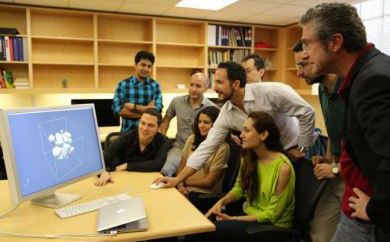Multiscale Modeling of Granular Matter for Earth and Space
Caltech
Problems
The goal of the geomechanics group at Caltech is to understand, model, and predict the mechanical behavior of granular materials, and hence contribute to the understanding of a wide range of natural and manmade processes such as liquefaction, landslides, and planetary exploration. Geomechanics aims to describe the mechanical behavior of geologic materials such as soils, rocks, and concrete. While significant progress has been made in understanding material behavior, much of it has been predicated on phenomenology. Access at lower scales was not available and engineering problems had to be solved. However, the phenomenological approach has neared its predictive limits, especially in predicting instabilities, which truly originate at the grain scale. It is only in recent years that access to the grain scale has become available experimentally (e.g., X-ray CT) and computationally (e.g., DEM). Yet most of these grain scale techniques remain qualitative and continue to lack connection with the macroscopic framework (e.g., plasticity theory, critical state soil mechanics).
Approach
In light of the aforementioned advances and challenges, there remain a number of fundamental questions that we are interested in and require answers: what is the micro-origin of macro-strength, strength-dilatancy? How is critical state achieved micromechanically? What is the micromechanical state at the onset of instabilities? Why are instabilities localized or diffused? How do fluid-solid material transitions occur even in granular materials? These questions take our group into the realm of engineering science and provide the intellectual motivation for our interdisciplinary work at Caltech. To attempt answering these fundamental questions, we combine concepts in mechanics, physics, applied math, computational science, and geoscience, to develop a number of computational and analytical tools: novel micromechanical models to compute and measure grain-scale states, accurate macroscopic frameworks, and multiscale techniques to connect macro and micro processes.
Findings
We are currently transforming micromechanical models such as DEM by accounting for particle shapes and by connecting the method directly to advanced experimental techniques based on imaging (e.g., X-ray CT). We have invented a method called granular element method (GEM) that moves beyond photoelasticity and enables the inference of interparticle forces in real (opaque), three dimensional, granular materials. These two techniques promise to transform experimental mechanics by enabling the extraction of kinematics and contact forces at the granular level with an unprecedented level of accuracy. These kinematics and forces at the grain level can then be used within the multiscale techniques that we have pioneered in granular mechanics, where basic plastic internal variables in continuum models are updated directly from the micromechanics. These advances are leading us to develop physics-based constitutive models that can be used to predict instabilities that are localized or diffused, drained or undrained.
Impact
The impact of the current advances in geomechanics is very broad, even in scales. From the micro scale, we can begin to understand the basic mechanisms at the heart of continuum phenomena such as compaction bands and critical state. At the meso scale, we can begin to understand the processes controlling granular flow, which impacts earthquake nucleation and landslides. At the engineering scale, we can begin to understand the complex interaction between rovers and sampling tools under low atmospheric pressure and gravity in celestial bodies or planets. We can begin to abandon phenomenology.
Core competencies
- Continuum mechanics
- Finite element modeling
- Computational particle mechanics
- Multiscale modeling
- Combined high-fidelity experimentation and advanced modeling

Current research team members:
- José E. Andrade (PI)
- Ivan Vlahinic (Senior Postdoc)
- Toktam Mohammadnejad (Postdoc)
- Daniel Arthur (Postdoc)
- Keng-Wit Lim (Ph.D. Candidate)
- Alex Jerves (Ph.D. Candidate)
- Utkarsh Mital (Ph.D. Candidate)
- Ryan Hurley (Ph.D. Candidate)
- Eloise Marteau (Ph.D. Student)
- Reid Kawamoto (Ph.D. Student)


